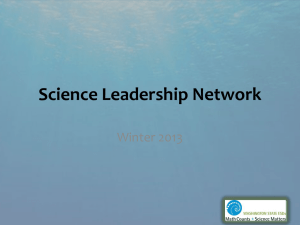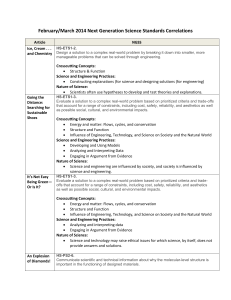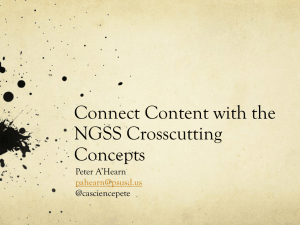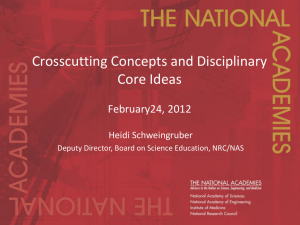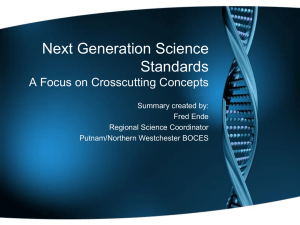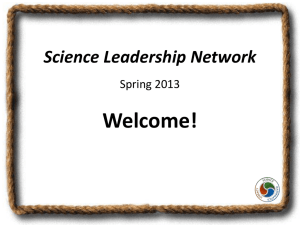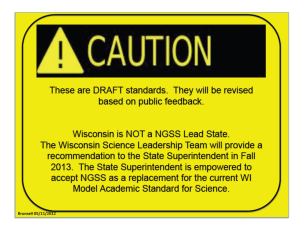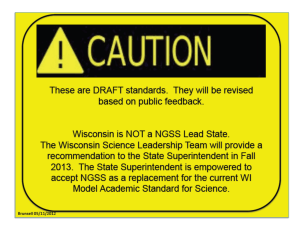PPT Presentation Slides
advertisement
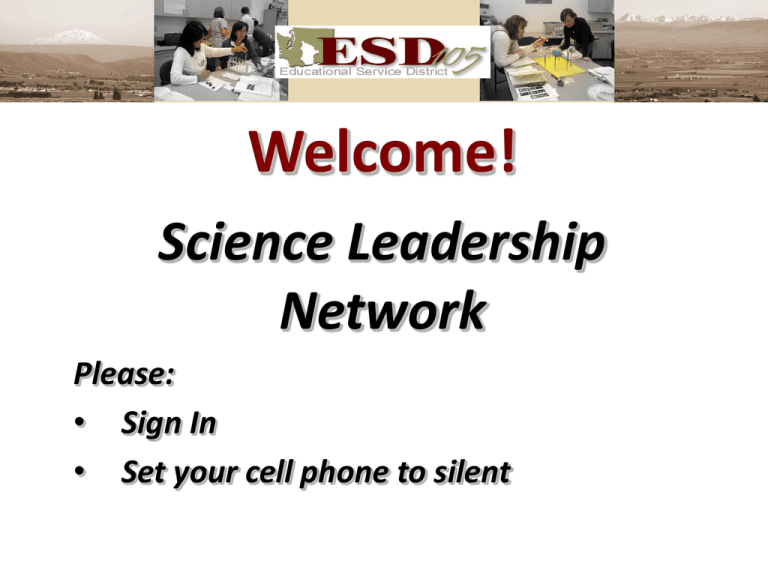
Welcome! Science Leadership Network Please: • Sign In • Set your cell phone to silent What is your Alter Ego? • Think of someone you admire that could be your “Alter Ego”. (For example: Albert Einstein, Marie Curie, Alfred E. Newman, etc.) • Write the name of your Alter Ego on a post-it note from your table box. Add this to your name tag. • Share with others at your table why you chose that person for your Alter Ego. A Chance to Network Options: • Revisit your action plan from October. • Discuss critical issues in your building or district that your team would like to problem solve. • Forecast an accomplishment you would like to walk away with today. Goals/Learning Intentions • Use models to analyze the Dimension 2 crosscutting scientific and engineering concepts from “A Framework for K-12 Science Education”. • Connect the Dimension 2 crosscutting scientific and engineering concepts to the WA K-12 Science Learning Standards. • Construct awareness of the timeline for the emergence of the Next Generation Science Standards in the State of Washington. • “Secret Squirrel” Goal. Open your journal to the next empty page…. • Create a title “Convection Currents” • Add the date into your entry • Add the following focus question… “How can we use models of convection currents to understand the crosscutting concepts?” Convection Currents and the Crosscutting Concepts Helping all students be successful … • What text features do you notice when you look at the first page in your handout? Convection Currents and the Crosscutting Concepts Helping all students be successful… • Addressing Tier 3 Vocabulary – Content specific – Low frequency Today’s word/phrase • Rheoscopic Fluid (fluid) Highlight in one color any time you see this word or phrase. Convection Currents and the Crosscutting Concepts Noting verbs.. • Highlight action verbs in a second color. • Do you notice anything about the position of the verbs? • Is there a difference in the placement of the verb compared to other kinds of writing? Complete the inquiry… • Follow the procedure on page one of your inquiry. • Make observations and record in your journal. • When you are finished complete the reflection questions on the second page of your handout. • Be ready to share your ideas. Thinking with Evidence 1. What patterns did you observe as the fluid moved? 2. What caused the fluid to move the way it did? What was the effect of the fluid movement? 3. How would the movement be different if this were on a larger scale like the mantle of the earth? 4. Describe how this set-up is a system. (Boundaries, flows, inputs, outputs, etc.) 5. Describe the flow of energy and matter in the set-up. 6. How does the shape of the bottle influence the movement of the water? 7. What would happen if the fluid in the jar became the same temperature as the heat source under the jar? Break! We will reconvene in 10 minutes Content Reading… • What text features do you notice? • Are there “models” in your content reading selections? – Choose only one selection to read. – Discuss reflection questions with a partner. – Answer question #8 in your journal. Thinking with Evidence • • How does the information • about the mantle relate to your “first-hand” observations of the model? Cite evidence from your journal • and the reading selection in your response How does the information about the atmosphere relate to your “first-hand” observations of the model? Cite evidence from your journal and the reading selection in your response Secret Squirrel Goal… Have we answered our focus question? • How can we use models of convection currents to understand the crosscutting concepts? Consider this….. Some important themes pervade science, mathematics, and technology and appear over and over again, whether we are looking at an ancient civilization, the human body, or a comet. They are ideas that transcend disciplinary boundaries and prove fruitful in explanation, in theory, in observation, and in design. ---American Association for the Advancement of Science Some important themes pervade science, mathematics, and technology and appear over and over again, whether we are looking at an ancient civilization, the human body, or a comet. They are ideas that transcend disciplinary boundaries and prove fruitful in explanation, in theory, in observation, and in design. ---American Association for the Advancement of Science What important “themes” are being described? Gallery Walk 1. Grab a partner and your Convection Currents packet. 2. Take a walk through our Gallery O’ Crosscutting Concepts. 3. Observe each Crosscutting Concept exhibit. Gallery Walk II 1. Revisit questions #1-7 on each part of the Convection Currents packet. 2. What patterns or connections do you observe between the exhibits and the questions? The Crosscutting Concepts 1. Pick up a copy of “A Framework for K-12 Science Education”. 2. If you do not already own a copy of this book, this one is yours! 3. Take a quick, self-directed tour of the book. 4. Read pages 83-85 (Stop at “Patterns”). Reflection: How can you leverage what you have learned this morning about the Crosscutting Concepts to optimize your work as a science educator? To learn more about Dimension 2 – The Crosscutting Concepts: • See Chapter 4 of the ‘Framework” book, pp 83-102. • Download this article from ESD 105’s Science Source: The Second Dimension – Crosscutting Concepts Understanding A Framework for K-12 Science Education by Richard Duschl (NSTA, February 2012) Lunch We will resume at 12:15 How will “A Framework for K-12 Science Education” impact our work? Why was “A Framework for K-12 Science Education” created? 1990s 1990s-2009 7/2010 – 3/2013 1/2010 - 7/2011 Phase I Phase II NGSS Lead States Vision for K-12 Science Education Students, over multiple years of school, actively engage in science and engineering practices and apply crosscutting concepts to deepen their understanding of the core ideas in these fields. A Framework for K-12 Science Education Read pp 23-30 Chapter 2: Guiding Assumptions and Organization of the Framework (Stop at “Dimension 3 – Disciplinary Core Ideas”) Standards Connections Washington Standards Four Essential Academic Learning Requirements – – – – Systems Inquiry Application Domains • Life Science • Physical Science • Earth and Space Science Next Generation Science Standards • Science and Engineering Practices – Identifies 8 Practices • Subsumes WA Inquiry & Application • Disciplinary Core Ideas – Adds Engineering and Technology • Crosscutting Concepts – Adds 7 crosscutting concepts • Subsumes WA Systems OSPI Presentation to SBE: Next Gen. Science Moving from Frameworks to NGSS Integrating the 3 Dimensions into a “Performance Expectation” How do the Crosscutting Concepts correlate to WA K-12 Science Standards? How do the Crosscutting Concepts correlate to WA K-12 Science Standards? Process: 1. Clear off your workspace. 2. Form groups of three to five with partners from your grade span. 3. Collect the following for your group: • WA MSP/Biology EOC Item Spec Cards • Crosscutting Concept posters (7 CC posters + Does Not Fit poster) 4. Split up the cards among the group and sort ‘em out on the posters. How do the Crosscutting Concepts correlate to WA K-12 Science Standards? Quick Write Reflection: 1. What claim could be made about the Crosscutting Concepts and WA Science Standards? 2. What is the evidence? What reason(s) can you make for your claim? Planning for the Future Think about next year’s Science Leadership Network. In light of what you experienced today, what topics would you like to dive into next year? • Next Generation Science Standards • CCSS ELA (Science connections) • TPEP (for the science classroom) • Science & Engineering Practices • STEM • MSP/EOC • Other? Planning for the Future Process: 1. Write the topic(s) you are interested in on a post-it note. 2. Place your post-it note votes on one of the chart posters. At our spring meeting you will choose the order the top three topics will be presented next year. Post Cards for the Future Fill out a post card with the following: • Your school address. • A description of something you want to accomplish based on what you learned today (by April 12). We will mail this post card to you in March as a reminder. Exit Tickets What we need from you: • Self-Addressed Post Card • Copy of your personal or team action plan • Completed “Content Evaluation” Final Thoughts • Use models to analyze the Dimension 2 crosscutting scientific and engineering concepts from “A Framework for K-12 Science Education”. • Connect the Dimension 2 crosscutting scientific and engineering concepts to the WA K-12 Science Learning Standards. • Construct awareness of the timeline for the emergence of the Next Generation Science Standards in the State of Washington. • “Secret Squirrel” Goal. How can you leverage what you have learned today about the Crosscutting Concepts to optimize your work as a science educator? Thank You! Science Leadership Network
